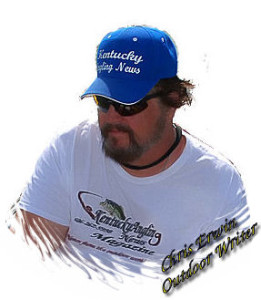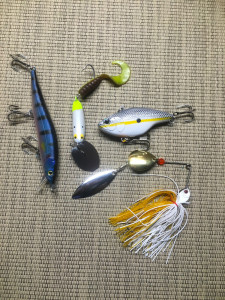BY Chris Erwin

[dc]I[/dc]n fishing there are a lot of unwritten rules. The 50 degrees rule is something I talk about all the time. When we see water temperatures either fall or rise near that figure in early spring or late fall, we believe bass are active. In today’s world of high technology, it is very possible for you to catch fish when water temperatures are colder than 50 degrees, but the rule remains very useful when we examine what’s likely to work at any given time.
In early spring, I try each year to talk about the green-water condition, where spring floods may hit a lake quickly and for a short time, some coves will remain green even when the main channel turns muddy and full of trash. Most of these coves don’t have creeks in them and while everything else becomes nearly unfishable, these green-water pockets will hold clear water. Fish will stack up in them until they shut the dam and flood these pockets with muddy water.
Spring is always a puzzle. Fish are beginning to leave their winter patterns to seek pre-spawn locations. When does this all start? This is a question I get often, and while there is a long list of things that must happen, fish are creatures of both instinctive urges and environmental factors. When you start to understand how they interact and progress together into spring you can begin to predict when and where fish are going to be. That doesn’t mean on any given day they are going to be active; however, if you know where to fish and what lures are most likely to work you are going to have some good days on the water.
Ok, it’s time to get to this “Rule of Seven.” As we discussed earlier while weather can always cancel any prediction, the rule of seven is this: When the sunrise is at 7 a.m., and sunset is 7 p.m. fish will be staging to move into shallow water.
Sunrise and sunset appearing at 7 and 7 is usually about a two-week period. For example, this year sunrise at 7 a.m. will happen March 10 of 2016, and sunset at 7 p.m. will happen on March 25. There is a little hiccup this year. Daylight Savings Time is going to happen this year on March 13 so instead of seven p.m. it’s going to be 8 p.m. but you get the idea.

During this period, I try to locate flats near deep water, and with the aid of a topo map and a depthfinder I will try to get positioned to cast where the shortest distance appears to be from deep water to the flat edges. Lures will very according to weather condition of that day. On a sunny day where the water temperatures jump 10 degrees or more, I’m for sure going to throw a jerkbait along with some type of lipless crankbait and chatterbait.
During this time of the year, you really need to examine every strike and try to adjust your lure choice and speed of retrieve according to weather for that day. However, the fish should be there and rather than running all over the place, I spend my time finding the best presentation and lure selection.
All the little rules do two things: No. 1 they give you something to look forward to, and No. 2 they also build your confidence. I cannot overstate the importance of confidence.
Back in my guiding days my goal was to get my client to believe in the lure he or she was throwing. If you believe you’re not going to catch anything, Hey, guess what? You’re unlikely to catch anything. However, once you believe, your focus changes and your presentation improves, which leads to better results.
So every piece of the puzzle you put together brings you a little closer to having that big day where everything is working. I’ll be the first to admit I have had disappointing days when I think I have done everything right, but they just won’t bite. The good part is, the more you build your fish knowledge the better results you will have, and you will quickly adjust when something isn’t working.
Chris Erwin is the Author of Camping Kentucky, founder and publisher of Kentucky Angling News an on-line magazine available at www.kentuckyangling.com/magazine Chris can be reached by email chris@ashlandbeacon.com


Be the first to comment